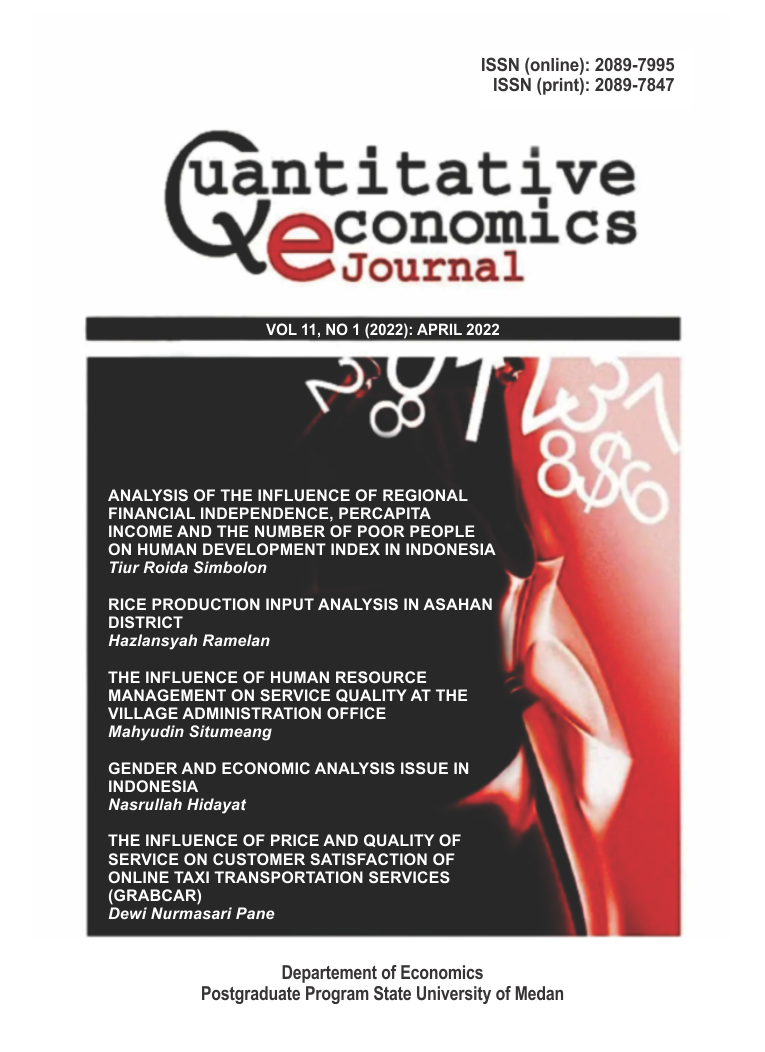KNOWLEDGE OF SHARIA BANKING ON THE INTEREST IN SAVING OF THE COMMUNITY IN NANGKA BINJAI UTARA VILLAGE VIEWED FROM SOCIAL DEMOGRAPHY ASPECT
DOI:
https://doi.org/10.24114/qej.v11i2.41516Abstract
This study aims to determine the knowledge of Islamic banking in the North Binjai community, especially in Kampung Nangka Village. As many as 60% of the population in the North Nangka Binjai sub-district have a livelihood as traders. The sample in this study was 30 people and used a non-probability sampling technique, namely the snow ball in determining the sample. Questionnaire Data analysis techniques use a single table. The results showed that banking knowledge of interest in saving in terms of demographic aspects. Based on the questionnaire that had been distributed, the responses given by 50 respondents indicated that they agreed with knowledge of Islamic banking products. As many as 28 people of the female sex with an age range of 21-25 years with recent education, mostly high school students, having an average income of 500,000-1,000,000 said they agreed that knowledge about Islamic bank products was easy to understand. This was mostly chosen by mothers who graduated from high school with an income of 500,000-1,000,000. then, most of the respondents agreed that knowledge about Islamic bank products was easy to understand so that they became interested in opening savings accounts in Islamic banks in the future._______________________________________________________Keywords: Islamic Banking, Interest in Saving, Social DemographicsReferences
Ahmad, N., & Haron, S. (2002). Perceptions of Malaysian corporate customers towards Islamic. Internation Journal of Islamic FInancial Service, 13-29.
Aurefanda, V. (2019). Pengaruh pengetahuan Mahasiswa Tentang Bank Syariah Terhadap Minat Menabung di Bank Syariah. Banda Aceh: Universitas Islam Negeri Ar-Raniry, Fakultas Ekonomi dan Bisnis Islam.
Binjai, K. A. (2021, 07 17). Presentase Penduduk Menurut Kecamatan dan Agama yang dianut di Kota Binjai, 2017. From Badan Pusa Statistik Kota Binjai: binjaikota.bps.go.id/statisticable/2018/12/26/329/presentase-penduduk-menurut-kecamatan-dan-agama-yang-dianut-di-kota-binjai-2017.html
Darmawan, D. (2014). Metode penelitian Kuantitatif Cetakan Kedua. Bandung: PT.Remaja Rosdakarya.
Khairunnisa, B. V., & Hendratmi, A. (2019). The Influence of Product Knowledge and Attitude Towards Intention in Mudharabah Funding Products in Sharia Banks in Mataram. The 2nd International Conference on Islamic Economics, Business, and Philanthropy (ICIEBP) Theme: œSustainability and Socio Economic Growth (pp. 663-677). KnE Social Sciences,. doi: DOI 10.18502/kss.v3i13.4239
Nasution. (2009). Metode Reaserch (Penelitian Ilmiah). Jakarta: Bumi Aksara.
Noor, & Juliansyah. (2016). Metodelogi Penelitian. Jakarta: Kencana Prenada Media Group.Panjka. 2000 Alfabeta.
OJK. (2021, 07 17). Perbankan Syariah dan Kelembagaannya. From Otoritas Jasa Keuangan: www.ojk.go.id/id/kanal/syariah/tentang-syariah/Pages/PBS-dan-kelembagaan.aspx
Rao, A., & Monroe, K. (1988). œThe moderating effect of prior knowledge on cue utilization in product evaluation. Journal of Consumer Reaserch, 15(2). doi: 10.1086/209162.
Setyobudi, W. T., Wiryono, S. K., Nasution, R. A., & Purwanegara, M. S. (2015). Exploring Implicit and Explicit Attitude Toward Saving at Islamic Bank. Journal of Islamic Marketing, 6(3), 314-330.
Singarimbun, Masri, & Effendi. (2010). Metode Penelitian Survey. Jakarta: Pustaka LP3ES Jakarta.
Sugiyono. (2012). Metode Penelitian Bisnis. Bandung: Alfabeta.
Suriasumantri, J. S. (2006). Ilmu dalam perspektif sebuah kumpulan karangan tentang Hakekat Ilmu. Jakarta: Yayasan Obor Indonesia.












